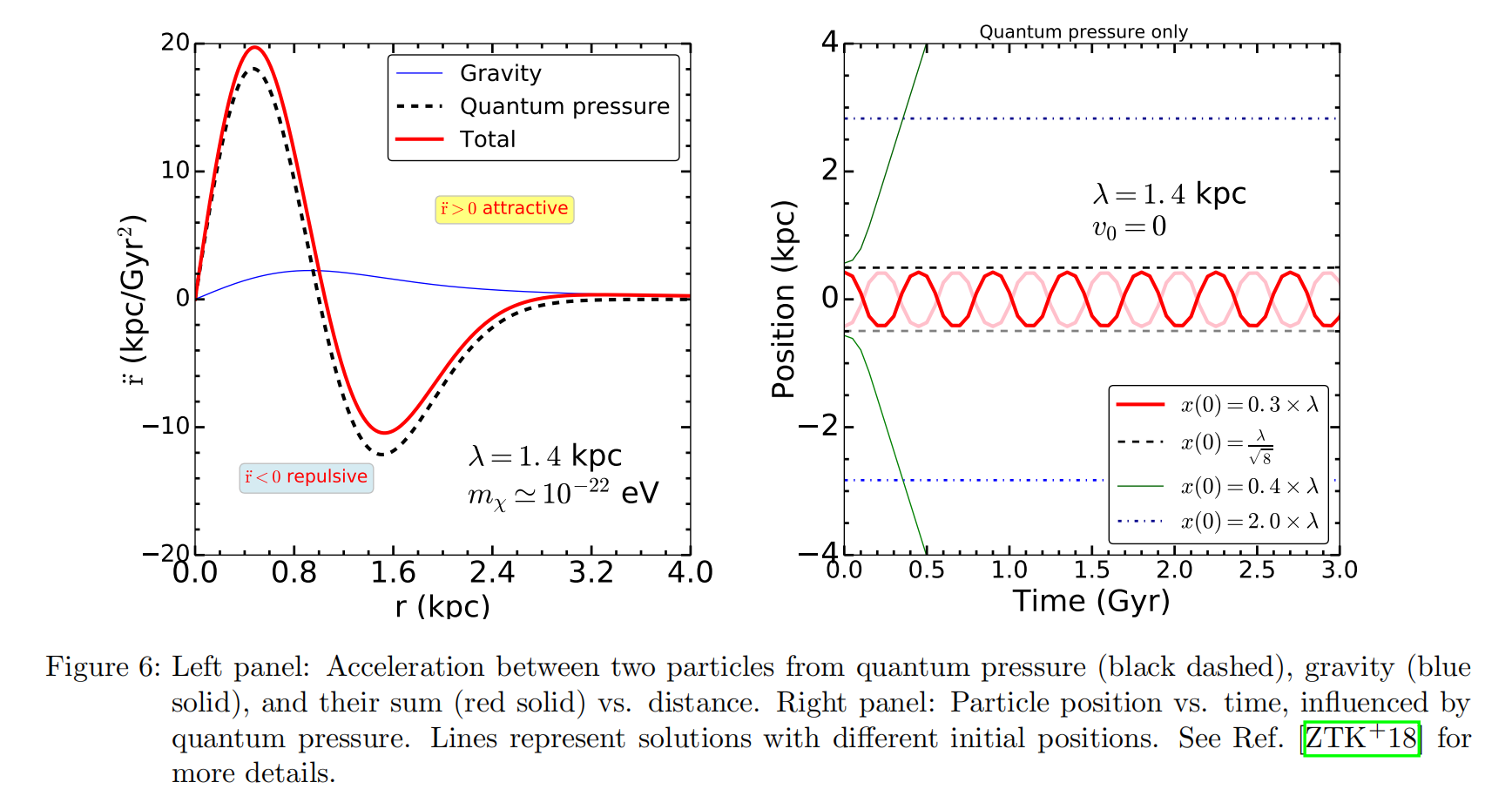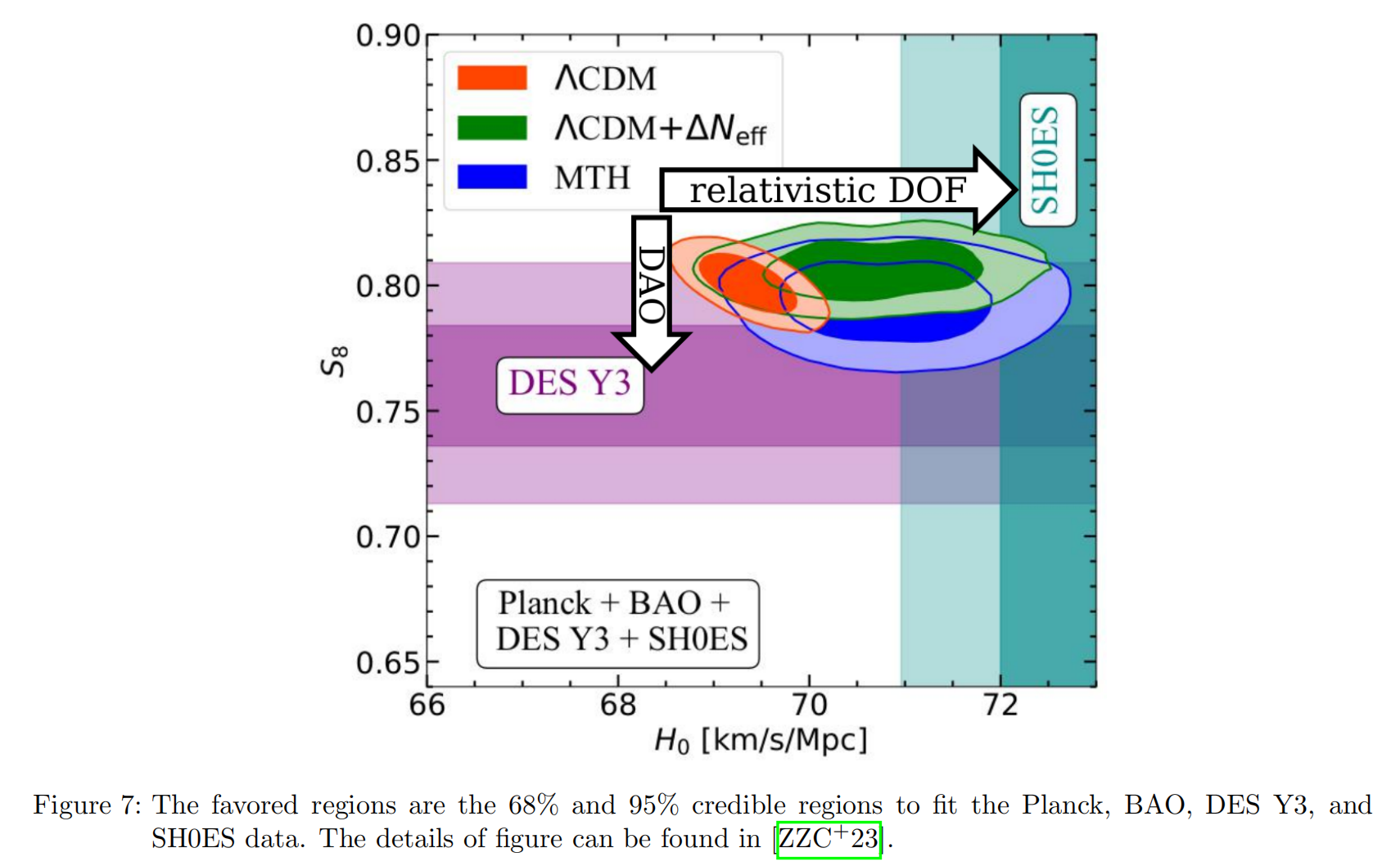Cosmology
Dark matter particles might interact through a short-range force, implying a heavy mediator particle that current colliders cannot detect. Some dark matter candidates have interactions too weak to affect the universe’s structure. However, short-range interactions can accumulate in super-dense dark matter regions on small cosmological scales. Ultra-light axions, despite their quantum effects like Bose-Einstein condensation, can still be detected on larger cosmological scales due to their matter wavelengths. WIMPs have measurable new physics energy scales but their interactions are challenging to detect due to contamination from baryon interactions. In contrast, ultra-light axions, with wavelengths around 1 kpc, are observable on larger cosmological scales, even if their new physics energy scales are too large for traditional detection methods: collider, direct detection, and indirect detection searches. Cosmological observations allow us to explore both large new physical scales and small scales from the early universe, making the studies of the cosmological evolution essential. Dark matter particle properties (like collisions) often leave imprints in early evolution equations, such as dark acoustic oscillations. Additionally, energy injection from dark matter annihilation or decay can significantly alter ionization history during recombination or reionization epochs. Our team’s research focuses on these two effects in dark matter cosmology.
1.Fuzzy Dark Matter and Structure Formation
Ultralight axions, known as fuzzy dark matter (FDM), are dark matter candidates with masses and de-Broglie wavelengths on the order of kiloparsecs. These axions thermalize through gravitational forces, forming a Bose–Einstein condensate as simply demonstration in Fig 6. Recent studies suggest that quantum pressure from FDM significantly impacts small-scale structure formation, potentially addressing the “small-scale crisis.” In work1, we have demonstrated FDM particle interactions in an $N$-body simulation to accurately model dark matter halo formation and its inner structure. We find a constant density solitonic core in a self-gravitationally bound virialized halo, consistent with theoretical predictions. This solitonic core reveals the nonlinear effects of quantum pressure on structure formation in the FDM model.

Lyman-alpha forest data from BOSS and XQ-100 suggest that the lower mass limit of FDM particles is around $10^{-21}$ eV. However, this limit was derived from $\Lambda$CDM simulations with FDM initial conditions, without considering quantum pressure, which could significantly impact large-scale structures. Our investigation of quantum pressure effects in cosmological simulations shows that quantum pressure further suppresses the matter power spectrum on small scales and the halo mass function at the low mass. We estimate quantum pressure effect on the 1D flux power spectrum of the Lyman-alpha forest and compare it with BOSS and XQ-100 data. We conclude that more systematic studies incorporating QP are necessary to constrain FDM particle mass using Lyman-alpha forest data.
2.Dark Matter Annihilation and Cosmological Probes
The latest EDGES results on the 21-cm absorption spectrum set stringent limits on dark matter annihilation cross-sections. We account for the heating energy released from dark matter annihilation during the reionization epoch into the 21-cm observation redshifts. Our findings2 indicate that the global 21-cm absorption profile is a powerful tool for probing dark matter interactions. For dark matter annihilating into electron–positron pairs, EDGES results provide a stricter upper limit on the annihilation cross-section in the lower dark matter mass region compared to Planck results.
We also investigate the impact of energy injection from dark matter annihilation on the cosmic microwave background power spectra using a residual likelihood map. By employing convolutional neural networks to identify underlying patterns3, we propose a new skill to constrain dark matter annihilation based on Planck 2018 data. Our trained neural network efficiently predicts likelihoods and accurately places bounds on the annihilation cross-section in a model-independent manner.
3.Dark acoustic oscillations: Mirror Twin Higgs Model and Dark Matter-Proton Scattering
Our first work to examine the potential of dark acoustic oscillation is based on the mirror twin Higgs model (MTH), which addresses the Higgs little hierarchy problem by introducing dark sector particles2.
We perform a Bayesian global analysis incorporating the latest cosmic shear measurement from the DES three-year survey, Planck CMB, and BAO data. In the early Universe, mirror baryons and radiation act as dark matter and dark radiation, altering the Universe’s expansion history. Additionally, mirror baryon-photon scattering generates dark acoustic oscillations, suppressing the cosmic shear matter power spectrum. We find that MTH dark matter cannot exceed about $30\%$ of the total dark matter density unless the twin photon temperature is less than $30\%$ of the standard model photon. The MTH model shows potential in alleviating both $H_0$ and $S_8$ tensions as shown in Fig7, particularly if future results approach those of the Planck SZ (2013) analysis. The future China Space Station Telescope (CSST) can determine the twin baryon abundance with 10% precision.

For investigating the elastic scattering cross-section between dark matter and protons, we also use DES Year 3 weak lensing data4. This scattering induces dark acoustic oscillations in the matter power spectra. To address non-linear effects at low redshift, we adopt principal component analysis and a limited set of $N$-body simulations to improve matter power spectrum predictions. Assuming different velocity dependencies, our results, presented as the first Frequentist upper limits, are compared with Bayesian results. Compared to Planck cosmic microwave background data, our findings from DES Year 3 data improve the limits by up to a factor of five. We also forecast future sensitivities of the China Space Station Telescope, which could improve current limits by approximately one order of magnitude.
-
Jiajun Zhang, Yue-Lin Sming Tsai, Jui-Lin Kuo, Kingman Cheung, and Ming-Chung Chu. Ultralight Axion Dark Matter and Its Impact on Dark Halo Structure in N -body Simulations. Astrophys. J., 853(1):51, 2018. ↩
-
Lei Zu, Chi Zhang, Hou-Zun Chen, Wei Wang, Yue-Lin Sming Tsai, Yuhsin Tsai, Wentao Luo, and Yi-Zhong Fan. Exploring mirror twin Higgs cosmology with present and future weak lensing surveys. JCAP,08:023, 2023 ↩ ↩2
-
Wei-Chih Huang, Jui-Lin Kuo, and Yue-Lin Sming Tsai. A convolutional-neural-network estimator of CMB constraints on dark matter energy injection. JCAP, 06:025, 2021. ↩
-
Chi Zhang, Lei Zu, Hou-Zun Chen, Yue-Lin Sming Tsai, and Yi-Zhong Fan. Weak Lensing Constraints on Dark Matter-Baryon Interactions with N -Body Simulations and Machine Learning. 2 2024. ↩